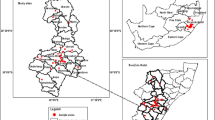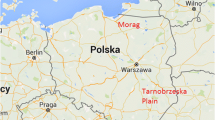Abstract
The metal (Cu, Ni, Cd, Hg, As, Pb) contents in wild edible mushrooms collected from three different sites in China were determined by atomic absorption spectrometry and atomic fluorescence spectrometry. All element concentrations were determined on a dry weight basis. A total of 11 species was studied, five being from the urban area and six from rural areas in China. The As content ranged from 0.44 to 1.48 mg/kg. The highest As content was seen in Macrolepiota crustosa from the urban area, and the lowest in Russula virescens from rural areas. A high Ni concentration (1.35 mg/kg) was found in Calvatia craniiformis from the urban area. The lowest Ni level was 0.11 mg/kg, for the species R. virescens and Cantharellus cibarius. The Cu content ranged from 39.0 to 181.5 mg/kg. The highest Cu content was seen in Agaricus silvaticus and the lowest in C. cibarius. The Pb content ranged from 1.9 to 10.8 mg/kg. The highest Pb value was found in C. craniiformis. The Cd content ranged from 0.4 to 91.8 mg/kg. The highest Cd value was found in M. crustosa. The Hg content ranged from 0.28 to 3.92 mg/kg. The highest Hg level was found in Agaricus species. The levels of the heavy metals Cd, Pb, and Hg in the studied mushroom species from urban area can be considered high. The metal-to-metal correlation analysis supported they were the same source of contamination. High automobile traffic was identified as the most likely source of the contamination. Based upon the present safety standards, consumption of those mushrooms that grow in the polluted urban area should be avoided.
Similar content being viewed by others
References
Alonso J, Salgado MJ, García MA, Melgar MJ (2000) Accumulation of mercury in edible macro fungi: influence of some factors. Arch Environ Contam Toxicol 38:158–162. doi:10.1007/s002449910020
Blanusa M, Kucak A, Varnai VA, Saric MM (2001) Uptake of cadmium, copper, iron, manganese, and zinc in mushrooms (Boletaceae) from Croatian forest soil. J AOAC Int 84:1964–1971
Byrne AR, Ravnik V, Kosta L (1976) Trace element concentrations in higher fungi. Sci Total Environ 6:65–78. doi:10.1016/0048-9697(76)90007-3
Council of Europe (2001) Policy statement concerning metals and alloys. Guidelines on metals and alloys used as food contact material. Council of Europe, EU, Brussels
Demirbaş A (2000) Accumulation of heavy metals in some edible mushrooms from Turkey. Food Chem 68:415–419. doi:10.1016/S0308-8146(99)00210-1
Demirbaş A (2001a) Concentrations of 21 metals in 18 species of mushrooms growing in the East Black Sea region. Food Chem 75:453–457. doi:10.1016/S0308-8146(01)00236-9
Demirbaş A (2001b) Heavy metal bioaccumulation by mushrooms from artificially fortified soils. Food Chem 74:293–301. doi:10.1016/S0308-8146(01)00155-8
FAO/WHO (1976) List of maximum levels recommended for contaminants by the Joint FAO/WHO Codex Alimentarius Commission, second series, vol 3. CAC/FAL, Rome, pp 1–8
Food and Nutrition Board (FNB) (2001) Dietary reference intakes for vitamin A, vitamin K, arsenic, boron, chromium, copper, iodine, iron, manganese, molybdenum, nickel, silicon, vanadium, and zinc. Institute of Medicine, National Academy Press, Washington, pp 1–28
García MA, Alonso J, Fernández MI, Melgar MJ (1998) Lead content in edible wild mushrooms in northwest Spain as indicator of environmental contamination. Arch Environ Contam Toxicol 34:330–335. doi:10.1007/s002449900326
Gast CH, Jansen E, Bierling J, Haanstra L (1988) Heavy metals in mushrooms and their relationship with soil characteristics. Chemosphere 17:789–799. doi:10.1016/0045-6535(88)90258-5
Grigalaviciene I, Rutkoviene V, Marozas V (2005) The accumulation of heavy metals Pb, Cu and Cd at roadside forest soil. Pol J Environ Stud 14:109–115
Isildak Ö, Turkekul I, Elmastas M, Tuzen M (2004) Analysis of heavy metals in some wild-grown edible mushrooms from the middle black sea region, Turkey. Food Chem 86:547–552. doi:10.1016/j.foodchem.2003.09.007
Järup L (2003) Hazards of heavy metal contamination. Brit Med Bull 68:167–182. doi:10.1093/bmb/ldg032
Kalač P, Svoboda L (2000) A review of trace element concentrations in edible mushrooms. Food Chem 69:273–281. doi:10.1016/S0308-8146(99)00264-2
Kalač P, Wittingerová M, Stašková I, Šimák M, Bastl J (1989) Contents of mercury, lead and cadmium in mushrooms. Cesk Hyg 34:568–576 (in Czech)
Kojo MR, Lodenius M (1989) Cadmium and mercury in macrofungi-mechanisms of transport and accumulation. Angew Bot 63:279–292
Laaksovirta K, Lodenius M (1979) Mercury content of fungi in Helsinki. Ann Bot Fenn 16:208–212
Lepsová A, Král R (1988) Lead and cadmium in fruiting bodies of macrofungi in the vicinity of a lead smelter. Sci Total Environ 76:129–138. doi:10.1016/0048-9697(88)90102-7
Lepsová A, Mejestrík V (1988) Accumulation of trace elements in fruiting bodies of macrofungi in the Krusne Hory Mountains Czecholovakia. Sci Total Environ 76:117–128. doi:10.1016/0048-9697(88)90101-5
Lodenius M, Kuusi T, Laaksovirta K, Liukkonen-Lilja H, Piepponen S (1981) Lead, cadmium and mercury contents of fungi in Mikkeli, SE Finland. Ann Bot Fennici 18:183–186
Mao XL (2000) Macrofungi of China. Henan Science and Technology Publishing House, Zhengzhou (in Chinese)
National Academy of Sciences (1975) Nickel. National Academy of Sciences, Washington, p 227
Nordberg G (2003) Cadmium and human health: a perspective based on recent studies in China. J Trace Elem Exp Med 16:307–319. doi:10.1002/jtra.10039
Ouzouni PK, Veltsistas PG, Paleologos EK, Riganakos KA (2007) Determination of metal content in wild edible mushroom species from regions of Greece. J Food Compost Anal 20:480–486. doi:10.1016/j.jfca.2007.02.008
Quinche JP (1987) Le cadmium, un élément présent en traces dans les sols, les plantes et les champignons. Revue Suisse Agric 19:71–77
Schellmann B, Hilz MJ, Opitz O (1980) Cadmium- und Kup-ferausscheidung nach Aufnahme von Champignon-Mahlzeiten. Z Lebensm Unters Forsch 171:189–192. doi:10.1007/BF01042648 (in German)
Schmitt JA, Meisch HU (1985) Cadmium in mushrooms-distribution, growth effects and binding. Trace Elem Med 2:163–166
Sesli E, Tüzen M (1999) Levels of trace elements in the fruiting bodies of macrofungi growing in the East Black Sea region of Turkey. Food Chem 65:453–460. doi:10.1016/S0308-8146(98)00194-0
Slekovec M, Irgolic KJ (1996) Uptake of arsenic by mushrooms from soil. Chem Spec Bioavailab 8:67–73
Stijve T, Bourqui B (1991) Arsenic in edible mushrooms. Dtsch Lebensmitt Rundsch 87:307–310
Svoboda L, Kalač P (2003) Contamination of two edible Agaricus spp. mushrooms growing in a town with cadmium, lead, and mercury. B Environ Contam Tox 71:123–130. doi:10.1007/s00128-003-0138-6
Svoboda L, Zimmermannova K, Kalač P (2000) Concentrations of mercury, cadmium, lead and copper in fruiting bodies of edible mushrooms in an emission area of copper smelter and a mercury smelter. Sci Total Environ 246:61–67. doi:10.1016/S0048-9697(99)00411-8
Tyler G (1980) Metals in sporophores of Basidiomycetes. Trans Br Mycol Soc 74:41–49
Vetter J (1994) Data on arsenic and cadmium contents of some common mushrooms. Toxicon 32:11–15. doi:10.1016/0041-0101(94)90016-7
Viard B, Pihan F, Promeyrat S, Pihan JC (2004) Integrated assessment of heavy metal (Pb, Zn, Cd) highway pollution: bioaccumulation in soil, Graminaceae and land snails. Chemosphere 55:1349–1359. doi:10.1016/j.chemosphere.2004.01.003
Wondratschek I, Röder U (1993) Monitoring of heavy metals in soils by higher fungi. In: Markert B (ed) Plants as biomonitors. Indicators for heavy metals in the terrestrial environment. VCH, Weinheim, pp 345–363
Yaman M, Akdeniz I (2004) Sensitivity enhancement in flame atomic absorption spectrometry for determination of copper in human thyroid tissues. Anal Sci 20:1363–1366. doi:10.2116/analsci.20.1363
Yang XE, Long XX, Ni WZ, Ye ZQ, He ZL, Stoffella PJ, Calvert DV (2002) Assessing copper thresholds for phytotoxicity and potential dietary toxicity in selected vegetable crops. J Environ Sci Health B 37:625–635. doi:10.1081/PFC-120015443
Yen TF (1999) Environmental chemistry: essentials of chemistry for engineering practice, vol 4. Prentice Hall, New Jersey
Acknowledgments
This work has been supported under the projects by the National Basic Research Program of China (No. 2004CB619204) and the National Natural Science Foundation of China (No. 50621063).
Author information
Authors and Affiliations
Corresponding author
Rights and permissions
About this article
Cite this article
Chen, XH., Zhou, HB. & Qiu, GZ. Analysis of Several Heavy Metals in Wild Edible Mushrooms from Regions of China. Bull Environ Contam Toxicol 83, 280–285 (2009). https://doi.org/10.1007/s00128-009-9767-8
Received:
Accepted:
Published:
Issue Date:
DOI: https://doi.org/10.1007/s00128-009-9767-8




